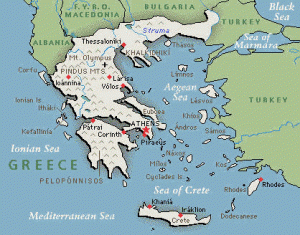In several previous posts, we have looked briefly at the women around St. Paul and his great respect for them (The Trials and Tribulations of Translating Scripture 2; Ancient Corinth II; and Paul’s Female Colleagues).  Here we will examine the women of Romans 16 in more depth (the full text of verses 1-23 are copied below).
Here we will examine the women of Romans 16 in more depth (the full text of verses 1-23 are copied below).
Paul probably dictated the letter to the Romans in the early spring of 57 CE. He mentioned at least nine women, and recent scholars have culled information on them by careful examination of the texts and the general social environment in which they and Paul lived. ![]() (Note that Paul mentioned approximately 17 men in Rom 16; thus over one-third of the people mentioned in this chapter were women.) We recently used a fascinating study by British scholar Peter Oakes to elucidate conditions in Christian communities in Rome by “marrying” archaeology and textual exegesis.
(Note that Paul mentioned approximately 17 men in Rom 16; thus over one-third of the people mentioned in this chapter were women.) We recently used a fascinating study by British scholar Peter Oakes to elucidate conditions in Christian communities in Rome by “marrying” archaeology and textual exegesis.
Let us meet in some detail the following women who worked around or were acquainted with St. Paul at Rome:
-
- Phoebe
- Prisca/Priscilla
- Mary
- Junia
- Tryphaena and Tryphosa
- Rufus’ mother
- Julia
- Nereus’ sister
Phoebe. Mentioned right away in Rom 16 is Phoebe (v. 1), who was probably a Gentile, as opposed to a Jesus-believing Jew (as we know, Paul spread the “gospel” primarily to non-Jews). According to Jouette Bassler (Women in Scripture, 134-35), Phoebe may have carried Paul’s letter to the Romans to the Romans. This would have constituted a very significant responsibility and also shows that women as well as men traveled extensively in the ancient world. Phoebe would have carried Paul’s letter perhaps from her home in Cenchreae, Corinth’s eastern port city, where she was a deacon in that community.  This fact is important and contrary to earlier male-dominated scholarship: deacon was a ministry of preaching and teaching and thus a leadership role over the whole church.
This fact is important and contrary to earlier male-dominated scholarship: deacon was a ministry of preaching and teaching and thus a leadership role over the whole church.
Paul also designates Phoebe as a prostatis, meaning leader, president, presiding officer, guardian or patron. The emphasis with this terminology is probably on patronage, which means that Paul was probably greatly in her debt, either financially or in some other way. We can also glean that she has some level of wealth and independence and does not seem to be defined by the men in her life. In short, Phoebe was Paul’s coworker, just like the men in this early Jesus community.
Prisca/Priscilla. Prisca (Priscilla is a diminutive form of Prisca) appears not only in Rom 16:3 but also in 1 Corinthians 16:19 (also written by Paul), Acts 18, and 2 Timothy. She is always mentioned with Aquila, her husband, and both of them probably worked as tentmakers. According to Bessler (Women in Scripture, 136-37), Phoebe was “a very important, well-traveled missionary and church leader whose work on occasion intersected with that of Paul.” The couple’s roles would have included preaching, teaching, and presiding over their house church. This house church group would have included slaves, freedmen, freedwomen, workers and others, and Prisca and Aquila were probably active in the Jesus movement before Paul met them in Corinth. The leader of this house church was most likely Priscilla, since she is listed first four of the six times she and Aquila appear in the New Testament texts.
 Prisca and Aquila were forced to leave Rome because of the Claudian edict expelling all Jews (49 CE). They moved back to Rome after 54 when the edict was lifted. Paul wrote to them there. They must have been relatively well off and may have been patrons or benefactors of Paul. They took risks doing this, as Paul indicates in Rom 16:4 (they “risked their necks for my life”). The fact that Priscilla was mentioned in 2 Tim 4:19 (“Greet Priscilla and Aquila and the household of Onesiphorus”), a letter that was written around 100-150 CE, shows that her memory lasted down through the ages.
Prisca and Aquila were forced to leave Rome because of the Claudian edict expelling all Jews (49 CE). They moved back to Rome after 54 when the edict was lifted. Paul wrote to them there. They must have been relatively well off and may have been patrons or benefactors of Paul. They took risks doing this, as Paul indicates in Rom 16:4 (they “risked their necks for my life”). The fact that Priscilla was mentioned in 2 Tim 4:19 (“Greet Priscilla and Aquila and the household of Onesiphorus”), a letter that was written around 100-150 CE, shows that her memory lasted down through the ages.
Junia. As we noted previously, Junia’s name was translated as masculine, Junias, in earlier modern commentaries and other sources, such as The New English Bible and The Wycliffe Bible Commentary. As scholar Bernadette Brooten concluded years ago (Women Priests, 142; Women in Scripture, 107; and Oxford Companion to the Bible, 405), however, Junia is actually a woman. Several facts point in this direction. First, the early church fathers attested her as female. Second, in ancient inscriptions, the male name Junias is unattested, but the female Latin name Junia occurs over 250 times in Greek and Latin inscriptions from Rome alone. Third, Junia is paired in Rom 16 with Andronicus – probably her husband.
Why would modern commentators insist on referring to Junia as a man, despite all the evidence to the contrary? Primarily because she becomes the only woman called an apostle in the New Testament; male scholars could not conceive that a woman could hold such an important leadership role. To be considered an apostle, she must have claimed to have seen the risen Christ and engaged in missionary work, and such a claim has long been viewed, especially by more orthodox Christian denominations, as pertaining only to men. Junia would not have held a leadership role only in the Jesus-believers group: she may have done this within the Jewish community before becoming an apostle of Christ.
It is likely that Junia had been in prison, perhaps for the gospel. She may have been a freedwoman or descendant of a slave freed by a member of the Junian clan.
Tryphaena and Tryphosa. According to Mary Rose D’Angelo (Women in Scripture, 165-66), the names of both of these women derive from a Greek verb having sexual overtones (“to live luxuriously,” etc.). Thus they may have been sex workers in the same brothel before conversion. They were probably also slaves or freedwomen with the same patron. Because “they are greeted with a single verb and adjective,” it is highly suggestive that they were lovers functioning as a missionary pair.
 Other missionary pairs in Rom 16 may have included Prisca and Aquila, Andronicus and Junia, Philologus and Julia, and Nereus and his “sister.” Elsewhere in Paul’s authentic letters we find Evodia and Syntyche (Phil 4:2), and we might also include Martha and Mary in the Gospel of Luke; the apostles Philip and Bartholomew (mentioned in all four Gospels); and the saints/Roman soldiers Serge/Sergius and Bacchus. Archaeological evidence supports the existence in early Christianity of missionary pairs, including same-sex couples (Abrahamsen, “Burials”).
Other missionary pairs in Rom 16 may have included Prisca and Aquila, Andronicus and Junia, Philologus and Julia, and Nereus and his “sister.” Elsewhere in Paul’s authentic letters we find Evodia and Syntyche (Phil 4:2), and we might also include Martha and Mary in the Gospel of Luke; the apostles Philip and Bartholomew (mentioned in all four Gospels); and the saints/Roman soldiers Serge/Sergius and Bacchus. Archaeological evidence supports the existence in early Christianity of missionary pairs, including same-sex couples (Abrahamsen, “Burials”).
Mary. Mary (Maria, Miriam, Mariam) was a very common name in antiquity and even in the New Testament texts. While Paul says almost nothing about this Mary, he does indicate that she “has worked very hard among you,” which suggests – for linguistic reasons, according to Bassler (Women in Scripture, 124) – that she exercised a leadership role in the gospel mission. The appearance of her name fairly early in Rom 16 further suggests that she was known personally to Paul. The Latin form of her name hints that she may have descended from the Roman clan of Marius.
Mother of Rufus. We do not even know the name of this woman, just her relationship: Rufus’ mother. However, Bassler (Women in Scripture, 469) has gleaned a bit more information from the text. This woman appears to have had a special relationship with Paul: his reference to her as his (figurative) “mother” probably means that she showed “generous hospitality” to Paul or perhaps served as his patron.
Julia. The derivation of this woman’s Latin name is “a woman of the gens, or clan, Julius.”  The name Julia was very common in antiquity, even among slaves. Unlike many commentaries, the New Jerusalem Bible pairs Julia with Philologus (correctly according to Bassler, Women in Scripture, 106), which suggests that he is Julia’s husband or brother. That she is mentioned by Paul along with the others in the same verse (15) – “all the saints who are with them” – suggests that these Jesus followers “constituted the nucleus of one of several small” Roman house churches.
The name Julia was very common in antiquity, even among slaves. Unlike many commentaries, the New Jerusalem Bible pairs Julia with Philologus (correctly according to Bassler, Women in Scripture, 106), which suggests that he is Julia’s husband or brother. That she is mentioned by Paul along with the others in the same verse (15) – “all the saints who are with them” – suggests that these Jesus followers “constituted the nucleus of one of several small” Roman house churches.
Sister of Nereus. The reference is fleeting, but we can discern that this woman is one of the several members of the small house church in Rome to which Paul was writing. Further, according to Bassler (Women in Scripture, 470), even though the term “sister” in antiquity could refer to Christian wives and coworkers, in this context Nereus and his sister were likely biological siblings and could also have been children of Julia and Philologus.
Summary
For much of the history of New Testament scholarship and early church history, the women mentioned by Paul in Rom 16 have either been mischaracterized or ignored. As we can see, however, they are actually revealed by modern feminist scholarship as significant actors in the development of the early Jesus movement. In one chapter in one of the earliest texts of the church we see that no fewer than one-third of the people mentioned – with gratitude – served the congregations and Paul himself as a deacon, an apostle, missionaries, preachers, patrons, leaders, and possible prisoners for the gospel.
There is no longer any reason for church officials – or anyone else – to diminish the important roles that women played in the early Jesus congregations.
*****
Text of Romans 16:1-23
1 I commend to you our sister Phoebe, a deacon of the church at Cenchreae,
2 so that you may welcome her in the Lord as is fitting for the saints, and help her in whatever she may require from you, for she has been a benefactor of many and of myself as well.
3 Greet Prisca and Aquila, who work with me in Christ Jesus,
4 and who risked their necks for my life, to whom not only I give thanks, but also all the churches of the Gentiles.
5 Greet also the church in their house. Greet my beloved Epaenetus, who was the first convert in Asia for Christ.
6 Greet Mary, who has worked very hard among you.
7 Greet Andronicus and Junia, my relatives who were in prison with me; they are prominent among the apostles, and they were in Christ before I was.
8 Greet Ampliatus, my beloved in the Lord.
9 Greet Urbanus, our co-worker in Christ, and my beloved Stachys.
10 Greet Apelles, who is approved in Christ. Greet those who belong to the family of Aristobulus.
11 Greet my relative Herodion. Greet those in the Lord who belong to the family of Narcissus.
12 Greet those workers in the Lord, Tryphaena and Tryphosa. Greet the beloved Persis, who has worked hard in the Lord.
13 Greet Rufus, chosen in the Lord; and greet his mother—a mother to me also.
14 Greet Asyncritus, Phlegon, Hermes, Patrobas, Hermas, and the brothers and sisters who are with them.
15 Greet Philologus [and] Julia, Nereus and his sister, and Olympas, and all the saints who are with them.
16 Greet one another with a holy kiss. All the churches of Christ greet you.
17 I urge you, brothers and sisters, to keep an eye on those who cause dissensions and offenses, in opposition to the teaching that you have learned; avoid them.
18 For such people do not serve our Lord Christ, but their own appetites, and by smooth talk and flattery they deceive the hearts of the simple-minded.
19 For while your obedience is known to all, so that I rejoice over you, I want you to be wise in what is good and guileless in what is evil.
20 The God of peace will shortly crush Satan under your feet. The grace of our Lord Jesus Christ be with you.
21 Timothy, my co-worker, greets you; so do Lucius and Jason and Sosipater, my relatives.
22 I Tertius, the writer of this letter, greet you in the Lord.
23 Gaius, who is host to me and to the whole church, greets you. Erastus, the city treasurer, and our brother Quartus, greet you.
Resources
Abrahamsen, Valerie. “Burials in Greek Macedonia: Possible Evidence for Same-Sex Committed Relationships in Early Christianity,” Journal of Higher Criticism, Vol. 4, No. 2 (Fall 1997) 33-56.
Bassler, Jouette M. “Julia,” in Carol Meyers, Toni Craven and Ross S. Kraemer, eds., Women in Scripture: A Dictionary of Named and Unnamed Women in the Hebrew Bible, the Apocryphal/Deuterocanonical Books, and the New Testament, 106-07. Grand Rapids, MI, and Cambridge, England: William B. Eerdmans Publishing Company, 2000.
Bassler, Jouette M., “Mary 7,” in Carol Meyers, Toni Craven and Ross S. Kraemer, eds., Women in Scripture: A Dictionary of Named and Unnamed Women in the Hebrew Bible, the Apocryphal/Deuterocanonical Books, and the New Testament, 124. Grand Rapids, MI, and Cambridge, England: William B. Eerdmans Publishing Company, 2000.
Bassler, Jouette M. “Mother of Rufus,” in Carol Meyers, Toni Craven and Ross S. Kraemer, eds., Women in Scripture: A Dictionary of Named and Unnamed Women in the Hebrew Bible, the Apocryphal/Deuterocanonical Books, and the New Testament, 469. Grand Rapids, MI, and Cambridge, England: William B. Eerdmans Publishing Company, 2000.
Bassler, Jouette M., “Phoebe,” in Carol Meyers, Toni Craven and Ross S. Kraemer, eds., Women in Scripture: A Dictionary of Named and Unnamed Women in the Hebrew Bible, the Apocryphal/Deuterocanonical Books, and the New Testament, 134-35. Grand Rapids, MI, and Cambridge, England: William B. Eerdmans Publishing Company, 2000.
Bassler, Jouette M., “Prisca/Priscilla,” in Carol Meyers, Toni Craven and Ross S. Kraemer, eds., Women in Scripture: A Dictionary of Named and Unnamed Women in the Hebrew Bible, the Apocryphal/Deuterocanonical Books, and the New Testament, 136-37. Grand Rapids, MI, and Cambridge, England: William B. Eerdmans Publishing Company, 2000.
Bassler, Jouette M., “Sister of Nereus,” in Carol Meyers, Toni Craven and Ross S. Kraemer, eds., Women in Scripture: A Dictionary of Named and Unnamed Women in the Hebrew Bible, the Apocryphal/Deuterocanonical Books, and the New Testament, 470. Grand Rapids, MI, and Cambridge, England: William B. Eerdmans Publishing Company, 2000.
Brooten, Bernadette J. “Junia,” in Bruce M. Metzger and Michael D. Coogan, eds., Oxford Companion to the Bible, 405. New York and Oxford: Oxford University Press, 1993.
Brooten, Bernadette J. “Junia,” in Carol Meyers, Toni Craven and Ross S. Kraemer, eds., Women in Scripture: A Dictionary of Named and Unnamed Women in the Hebrew Bible, the Apocryphal/Deuterocanonical Books, and the New Testament, 107. Grand Rapids, MI, and Cambridge, England: William B. Eerdmans Publishing Company, 2000.
Brooten, Bernadette J. “‘Junia … Outstanding among the Apostles’ (Romans 16:7),” in Leonard J. Swidler and Arlene Swidler, eds., Women Priests: A Catholic Commentary on the Vatican Declaration, 142. New York: Paulist, 1977.
Brooten, Bernadette J. Women Leaders in the Ancient Synagogue, Brown Judaic Studies no. 36. Chico, CA, 1982.
D’Angelo, Mary Rose. “Tryphaena,” in Carol Meyers, Toni Craven and Ross S. Kraemer, eds., Women in Scripture: A Dictionary of Named and Unnamed Women in the Hebrew Bible, the Apocryphal/Deuterocanonical Books, and the New Testament, 165-66. Grand Rapids, MI, and Cambridge, England: William B. Eerdmans Publishing Company, 2000.
D’Angelo, Mary Rose. “Tryphosa,” in Carol Meyers, Toni Craven and Ross S. Kraemer, eds., Women in Scripture: A Dictionary of Named and Unnamed Women in the Hebrew Bible, the Apocryphal/Deuterocanonical Books, and the New Testament, 166. Grand Rapids, MI, and Cambridge, England: William B. Eerdmans Publishing Company, 2000.
D’Angelo, Mary Rose. “Women Partners in the New Testament,” Journal of Feminist Studies in Religion 6 (1990) 65-86.
Kirby, Peter. Early Christian Writings, http://www.earlychristianwritings.com/. Based on respected scholarship, Kirby dates Colossians to 50-80 CE; Ephesians to 80-100 CE; I and II Timothy and Titus to 100-150.
Oakes, Peter. Reading Romans in Pompeii: Paul’s Letter at Ground Level. London: SPCK and Minneapolis: Fortress Press, 2009.
